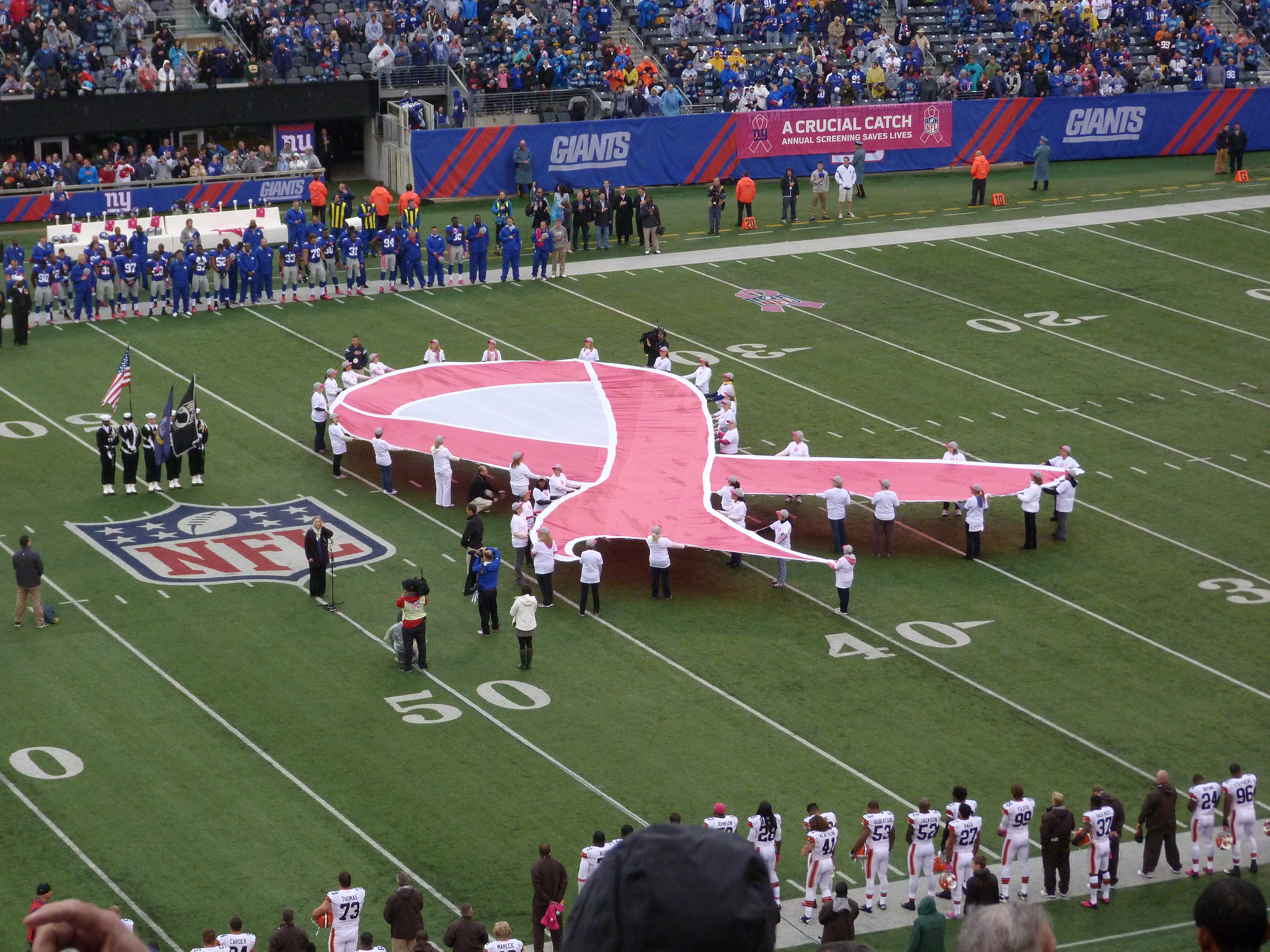A pastel pink ribbon, looped once, pinned to the lapel of a photogenic model, iced onto a biscuit or sold at a charity fundraiser. Now made gigantic and carried out on to a football pitch. A pink ribbon is lightweight, neat, cheerful – everything breast cancer is not. Perhaps because of this, as a symbol of awareness for the disease, it has endured.
You may even be familiar with the story of its origin.
It is 1992, and Self – “a magazine for women that specializes in health, beauty and style” – is compiling its annual breast cancer awareness special issue. Editor in chief Alexandra Penney, and Evelyn Lauder – senior at cosmetics company Estée Lauder – read a column about 68-year-old Charlotte Haley, who is distributing peach-coloured ribbons with the accompanying message
“National Cancer Institute annual budget is $1.8 Billion. Only 5% goes for cancer prevention. Help us to wake up our legislators and America by wearing this ribbon.”
Haley’s work is covered in the LA Times, described as a “personal, simple effort”. Alexandra Penney, market savvy, sees promise in the little peach ribbons, and calls Haley up to ask permission to use her idea in Self’s national campaign. Haley starkly refuses: ‘Too commercial.’ Taken aback, Penney and Lauder consult their lawyers. They are told, to their joy, that if they change the colour of the ribbon, they avoid the problem of permission. Peach loses its blush and becomes pastel pink. The edition of the magazine is a success and ribbons are distributed at Estée Lauder cosmetics counters nationwide. It only gains more traction after that; today the pink ribbon is the most recognisable symbol of breast cancer awareness.
This is a succinct narrative, perhaps even an accurate one.
Online coverage of this story is patchy, with evidence of cut and paste from a 1997 account of it by Sandy M Fernandez, in which Alexandra Penney is interviewed. “You know how it is when things are in the air,” she says breezily to Fernandez of the atmosphere in the Self office before the special issue was released. Being the one who popularised the ribbon, Penney gets the last word.
There is something in the story that resists reimagination. For a start, the tale – a small-scale campaign engulfed by corporate power – has a strong arc, and feels complete. Secondly, Charlotte Haley passed away in 2014, so opportunities to interview primary sources are dwindling.
On top of this, rather than historical truth, pieces covering this story are often preoccupied with a different purpose – usually advocating breast cancer awareness. To illustrate the lack of imaginative re-examination of the story: the cards Haley distributed with an attached peach ribbon implore their recipients to “join the grassroots movement.” The word ‘grassroots’ has been latched on to in almost every account I have found online. “Haley was strictly grassroots,” “It’s a grassroots movement,” “a grassroots effort,” “Charlotte’s grassroots campaign.” It is clear that in the pink ribbon story each rewrite did not have access to any new material.
Due to the PR success of the pink ribbon, the story is looked back upon uncritically. Charlotte Haley is rightly seen as inspiring; the more controversial Alexandra Penney is not an idea thief but merely “market-savvy”.
There is one notable dissenter: Katherine O’Brien, on her blog ihatebreastcancer. After a rare well-researched account of the pink ribbon story, she wonders if the profits from that year’s breast cancer awareness issue of Self will be donated to research, or, more likely, kept by the company. O’Brien ends the blog post with a burst of righteous anger:
“Well, as one of 150,000 U.S. people currently living with metastatic breast cancer, I want people to know that Oct. 13 is National Metastatic Breast Cancer Awareness Day. In the U.S., incidence of stage IV breast cancer—the cancer that is lethal—has stayed the same over the past 20 years; screening and improved treatment has not changed this.
“I am not among the millions of people who subscribe to Self. If I were, I would rip out every page of breast cancer related advertising and return it to editor in chief Lucy Danziger and tell her I support groups that support research. I would ask her to write about people with metastatic breast cancer and help readers understand why it is different from early-stage breast cancer. I would ask her to do an article on recurrence. I would ask her if she thinks we have enough awareness.”
This shatters abruptly images of pastel pink ribbons adorning photogenic models. The post begins to chip away at the original narrative from an oblique angle. O’Brien does not refute the facts, and instead highlights how tangential – and potentially obscuring – the media friendly pink ribbon tale can be to more painful issues. Like the fact that breast cancer is the second most common cause of death in women in the UK. Or that an estimated 12,000 women are living with undiagnosed breast cancer due to the pandemic’s disruption to screening services.
Only the journalism from 1992 manages to capture any of the urgency and momentum of Charlotte Haley’s project. The story and imagery today has become folklore, an American tale of the elephant and the mouse, disconnected from crueller realities. The story functions the way a pink ribbon does. Both bring to mind ideas of ‘awareness’, which can certainly be positive, but are unproductivel if the thought goes no further than that.
Neither bring home the grief of living with, or living alongside someone with, breast cancer. As much as progress has been made, breast cancer remains a deadly, frightening disease that has cut many, many lives tragically short. For the pink ribbon, superficial awareness is a start, but its inability to capture the devastation the disease still causes is where its symbolism ultimately fails.
Image Credit: Marianne O’Leary/CC BY 2.0



